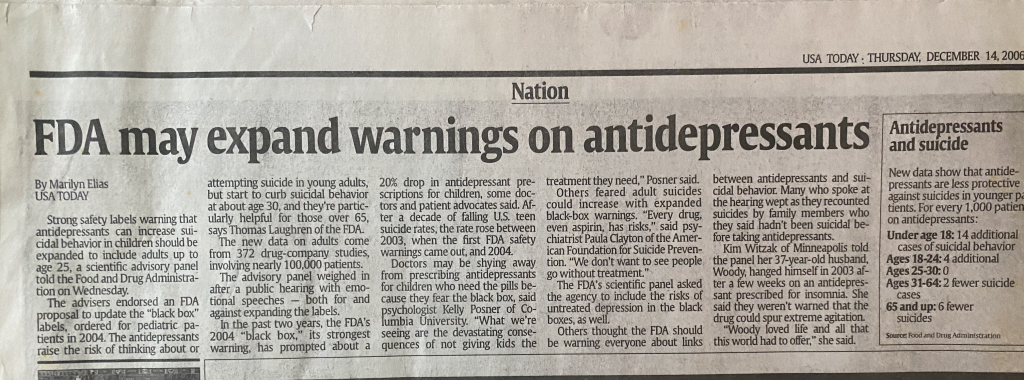Do SSRI Antidepressants Cause Mass Shootings?
https://www.midwesterndoctor.com/p/the-evidence-ssri-antidepressants

A Closer Look at Decades of Evidence • Once the SSRIs entered the market, there has been a wave of SSRI suicides and unspeakable acts of violence. • SSRI antidepressants have a variety of horrendous side effects. These include sometimes causing the individual to become agitated, feeling they can’t be in their skin, turning psychotic, and occasionally becoming violently psychotic. • During these psychoses, individuals can have out of body experiences where they commit lethal violence either to themselves or others. • As lawsuits later showed, this violent behavior (and the frequent suicides that followed it) were observed throughout the SSRI clinical trials, but were covered up by the SSRI manufacturers and then the drug regulators (e.g., the FDA). • Sadly, the idea that SSRIs could cause any of this has always been viewed as a “conspiracy theory” or “mistaking correlation with causation” because very few are aware of the extensive evidence linking SSRIs to violent and psychotic behavior—despite it now being on the warning label of those drugs. This post was a condensed version of an article written by
@MidwesternDoc (give him a follow).
……………..
Dec 14 2006 USA Today headline reporting on FDA Psychopharmacologic Drug Advisory Committee Hearing when I testified & Black Box WARNINGS were expanded. FDA only added warnings for ppl under age 25 b/c they didn’t want to deter ppl from taking the drugs. I was 31. Profit over people.

……………..
5 Reasons to think twice about SSRIS
……………..

5000+ Official Database of News articles documenting antidepressant-induced violence and bizarre behavior.
https://ssristories.net/archive/indexb6a1.html?sort=date&p=
……………..
……………….
Psychiatric Drugs & Violence—The Facts
Psychiatric Drugs—Regulatory Warnings on Violence, Mania, Psychosis, Homicide
Fact: Despite 49 international drug regulatory warnings on psychiatric drugs citing effects of mania, hostility, violence and even homicidal ideation, and dozens of high profile shootings/killings tied to psychiatric drug use, there has yet to be a federal investigation on the link between psychiatric drugs and acts of senseless violence.
Fact: At least 39 school shootings and/or school-related acts of violence have been committed by those taking or withdrawing from psychiatric drugs resulting in 200 wounded and 100 killed (in other school shootings, information about their drug use was never made public—neither confirming or refuting if they were under the influence of prescribed drugs).
Fact: Between 2004 and 2012, there have been 14,773 reports to the U.S. FDA’s MedWatch system on psychiatric drugs causing violent side effects including: 1,531 cases of homicidal ideation/homicide, 3,287 cases of mania & 8,219 cases of aggression. Note: The FDA estimates that less than 1% of all serious events are ever reported to it, so the actual number of side effects occurring are most certainly higher.
School-related acts of violence aren’t the only cases commonly found to be under the influence of psychiatric drugs. There are 64 other acts of senseless violence committed by individuals taking or withdrawing from psychiatric drugs resulting in an additional 432 dead and 773 wounded.
Click to read MANIA—The shocking link between psychiatric drugs, suicide, violence and mass murder
To read all drug regulatory agency warnings & studies on psychiatric drugs, visit CCHR’s Psychiatric Drug Side Effects Search Engine.
The Drug Regulatory Agency Warnings on Psychiatric drugs and violence, mania, psychosis or homicide:
- United States, January 6, 2022: The FDA updated the safety label for Strattera (atomoxetine) to warn of the possibility of the drug causing the emergence or worsening of aggressive behavior or hostility. In addition, bipolar disorder patients may be at an increased risk of developing mania or mixed episodes when taking Strattera. Patients and caregivers are to be instructed to look for signs of activation of mania or hypomania.
Source: “STRATTERA (NDA-021411) Drug Safety-related Labeling Changes Approved By FDA Center for Drug Evaluation and Research (CDER),” Food and Drug Administration, 6 Jan 2022.
- United States, November 10, 2021: The FDA updated the safety label for Effexor XR (venlafaxine) to include postmarketing reports of serious discontinuation symptoms including completed suicide, suicidal thoughts, aggression, and violent behavior while reducing dosage or discontinuing the drug.
Source: “EFFEXOR XR (NDA-020699) Drug Safety-related Labeling Changes Approved By FDA Center for Drug Evaluation and Research (CDER),” Food and Drug Administration, 10 Nov 2021.
- United States, November 10, 2021: The FDA updated the safety label for Pristiq (desvenlafaxine) to note that there have been postmarketing reports of serious discontinuation symptoms including completed suicide, suicidal thoughts, and aggression (including hostility, rage, and homicidal ideation) while reducing dosage or discontinuing the drug.
Source: “PRISTIQ (NDA-021992) Drug Safety-related Labeling Changes Approved By FDA Center for Drug Evaluation and Research (CDER),” Food and Drug Administration, 10 Nov 2021.
- United States, March 4, 2021: The FDA updated the safety label for Symbyax (a combination of the antipsychotic olanzapine & antidepressant fluoxetine) in the Postmarketing Experience section for each drug. Under fluoxetine, reported adverse reactions included violent behavior.
Source: “SYMBYAX (NDA-021520) Drug Safety-related Labeling Changes Approved By FDA Center for Drug Evaluation and Research (CDER),” Food and Drug Administration, 4 Mar 2021.
- United States, March 1, 2021: The FDA updated the safety labels for Xanax and Xanax XR (alprazolam) to note in the Warnings and Precautions section that, “Benzodiazepines may worsen depression.” Appropriate precautions (e.g., monitoring for suicidal ideation) should be considered for those with depression. The Postmarketing Experience subsection under Adverse Reactions was updated to include hypomania and mania.
Source: “XANAX (NDA-018276) Drug Safety-related Labeling Changes Approved By FDA Center for Drug Evaluation and Research (CDER),” Food and Drug Administration, 1 Mar 2021; “XANAX XR (NDA-021434) Drug Safety-related Labeling Changes Approved By FDA Center for Drug Evaluation and Research (CDER),” Food and Drug Administration, 1 Mar 2021.
- United States, November 13, 2020: The FDA updated the safety label for Trintellix (vortioxetine) to include aggression, agitation, anger, hostility, and irritability under Postmarketing Experience in the Adverse Reactions section.
Source: “TRINTELLIX (NDA-204447) Drug Safety-related Labeling Changes Approved By FDA Center for Drug Evaluation and Research (CDER),” Food and Drug Administration, 13 Nov 2020.
- United States, February 5, 2019: The FDA updated the safety label for Dyanavel XR (amphetamine). The following was added to the Adverse Reactions section: restlessness, irritability, euphoria, dyskinesia (uncontrolled, involuntary muscle movements), dysphoria, depression, tremor, aggression, anger, logorrhea (excessive and often incoherent wordiness when talking), among other side effects.
Source: “DYANAVEL XR (NDA-208147) Drug Safety-related Labeling Changes Approved By FDA Center for Drug Evaluation and Research (CDER),” Food and Drug Administration, 5 Feb 2019.
- Australia, June 1, 2018: The Therapeutic Goods Administration issued a Medicine Safety Update on Champix (varenicline), bupropion [Wellbutrin], sodium valproate [Epilim], carbamazepine [Tegretol], levetiracetam [Keppra], phenytoin [Dilantin], lamotrigine [Lamictal], topiramate [Topamax], pregabalin [Lyrica], gabapentin [Neurontin], and Strattera (atomoxetine) being associated with neuropsychiatric adverse effects. It stated, “Neuropsychiatric adverse events can range from mild to severe, and encompass a broad range of symptoms including tremor, agitation, aggressive behaviour or hostility, anxiousness, depression, dream abnormalities, hallucinations, insomnia, irritability, restlessness, somnambulism [sleepwalking], suicidal thinking and behaviour.”
Source: “TGA Medicines Safety Update,” Vol. 9, No. 2, June 2018.
- United States, October 25, 2017: The FDA updated the safety label for Klonopin (clonazepam)’s to state under Precautions, “Paradoxical reactions, such as agitation, irritability, aggression, anxiety, anger, nightmares, hallucinations, and psychoses are known to occur when using benzodiazepines. Should this occur, the use of the drug should be discontinued gradually. Paradoxical reactions are more likely to occur in children and in the elderly.” It also warned that Klonopin can cause respiratory depression. Aggression, disturbance in attention, and anger were all added to the Adverse Reactions section.
Source: “KLONOPIN (NDA-017533), Safety Labeling Changes Approved By FDA Center for Drug Evaluation and Research (CDER),” Food and Drug Administration, 25 Oct 2017.
- United States, July 31, 2017: The FDA updated the safety label for Vyvanse (lisdexamfetamine) to include adverse reactions reported in the Clinical Trial Experience section. For ages 6 to 12, reports included anger, among other adverse reactions. For ages 13 to 17, reports included irritability and mood swings in addition to other physical adverse reactions. For adults, reports included agitation, depression, paranoia, and restlessness.
Source: “Safety Labeling Changes Approved By FDA Center for Drug Evaluation and Research (CDER),” Food and Drug Administration, 31 Jul 2017….
https://www.cchrint.org/psychiatric-drugs/drug_warnings_on_violence
………………..
………………..
An Uncomfortable Truth: Does the Rise of Antidepressants and SSRIs Fuel Mass Shootings?
………………
……………..
THE TRUTH ABOUT THE DRUG COMPANIES: HOW THEY DECEIVE US AND WHAT TO DO ABOUT IT
Interview with Marcia Angell Former Editor for the New England Journal of Medicine
During her two decades at The New England Journal of Medicine, Dr. Marcia Angell had a front-row seat on the appalling spectacle of the pharmaceutical industry. She watched drug companies stray from their original mission of discovering and manufacturing useful drugs and instead become vast marketing machines with unprecedented control over their own fortunes. She saw them gain nearly limitless influence over medical research, education, and how doctors do their jobs. She sympathized as the American public, particularly the elderly, struggled and increasingly failed to meet spiraling prescription drug prices. Now, in this bold, hard-hitting new book, Dr. Angell exposes the shocking truth of what the pharmaceutical industry has become–and argues for essential, long-overdue change.
Currently Americans spend a staggering $200 billion each year on prescription drugs. As Dr. Angell powerfully demonstrates, claims that high drug prices are necessary to fund research and development are unfounded: The truth is that drug companies funnel the bulk of their resources into the marketing of products of dubious benefit. Meanwhile, as profits soar, the companies brazenly use their wealth and power to push their agenda through Congress, the FDA, and academic medical centers.
Zeroing in on hugely successful drugs like AZT (the first drug to treat HIV/AIDS), Taxol (the best-selling cancer drug in history), and the blockbuster allergy drug Claritin, Dr. Angell demonstrates exactly how new products are brought to market. Drug companies, she shows, routinely rely on publicly funded institutions for their basic research; they rig clinical trials to make their products look better than they are; and they use their legions of lawyers to stretch out government-granted exclusive marketing rights for years. They also flood the market with copycat drugs that cost a lot more than the drugs they mimic but are no more effective.
The American pharmaceutical industry needs to be saved, mainly from itself, and Dr. Angell proposes a program of vital reforms, which includes restoring impartiality to clinical research and severing the ties between drug companies and medical education. Written with fierce passion and substantiated with in-depth research, The Truth About the Drug Companies is a searing indictment of an industry that has spun out of control.
AUDIO^
